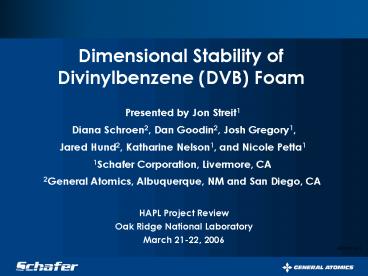Dimensional Stability of Divinylbenzene DVB Foam - PowerPoint PPT Presentation
1 / 10
Title:
Dimensional Stability of Divinylbenzene DVB Foam
Description:
Gelled for 18 and 48 hours. Exchanged through the process solvents and measured. Purpose: ... up to a 1% expansion and about a 2% shrinkage. ... – PowerPoint PPT presentation
Number of Views:51
Avg rating:3.0/5.0
Title: Dimensional Stability of Divinylbenzene DVB Foam
1
Dimensional Stability of Divinylbenzene (DVB) Foam
Presented by Jon Streit1 Diana Schroen2, Dan
Goodin2, Josh Gregory1, Jared Hund2, Katharine
Nelson1, and Nicole Petta1 1Schafer Corporation,
Livermore, CA 2General Atomics, Albuquerque, NM
and San Diego, CA
HAPL Project Review Oak Ridge National
Laboratory March 21-22, 2006
2
Why Study Dimensional Stability?
- We have observed shells shrinking after critical
point drying. - We have had poor coating yields.
- Large changes in foam shell dimensions could
cause overcoats to fail. - If we want to have a foam target with a conformal
overcoat then either - Both the foam and the overcoat do not change.
- Both the foam and the overcoat change the same
amount ( or -). - The overcoat must be elastic enough to withstand
the change.
- We needed to further investigate foam stability
as it might be affecting the overcoat
3
How does crosslinking affect dimensional
stability?
- A linear polymer (a) can be dissolved in a
solvent. - A crosslinked polymer (b) can swell in a good
solvent and shrink in a poor solvent. - The degree of crosslinking determines the
dimensional stability of the system.
4
Study 1 Intrinsic properties of DVB foam
- Can DVB be made dimensionally stable?
- DVB cast in rods
- Advantages ease of measurement, large volume
equals large changes - Precise control
- Variables polymerization time, polymerization
solvent, polymerization initiator (AIBN), and the
limit of theoretical crosslinking (by adding
styrene). - The test for stability was to place the foam in a
good solvent (xylene) and a poor solvent
(isopropyl alcohol) and measure dimensional
changes.
5
Results of Study 1 there are conditions where
the foam is dimensionally stable.
Most stable, 100 DVB, 6 AIBN, Diethyl
phthalate
Current condition, 100 DVB, 3 AIBN, Dibutyl
phthalate
6
This result suggests processing changes.
Most stable, 100 DVB, 6 AIBN, diethyl
phthalate
- 100 DVB is a surprise as the system should have
been robust enough to have withstood the addition
of some styrene, if we are achieving most of the
theoretical crosslink density. - 6 AIBN is a surprise, this is a very large ratio
of initiator to monomer.
7
Study 2 Stability in Current Process Conditions
- Rods and shells were
- Gelled for 18 and 48 hours.
- Exchanged through the process solvents and
measured. - Purpose
- Determine conditions the overcoat must withstand
or match. - Establish a baseline for future dimensional
stability improvement. - Compare results of rods and shells.
8
Study 2 Process Flow
Dibutyl Phthalate
Isopropyl Alcohol
Diethyl Phthalate
Isopropyl Alcohol
Dry
- If the foam and the coating do not exchange and
contract the same amount, overcoat failure can
occur.
9
Study 2 Results
Important exchanges for overcoat.
Change too small to measure.
- Process solvents Dibutyl Phthalate (DBP),
Isopropyl Alcohol (IPA), Diethyl Phthalate (DEP)
- The rod data suggests that the coating may need
to withstand - up to a 1 expansion and about a 2
shrinkage. - Discrepancies between rod and shell data need
to be understood.
10
Conclusions
- Study 1 suggests higher AIBN 100 DVB to
minimize changes. - Either need to stop shrinkage of foam or find an
alternate overcoat that matches shrinkage. - Next steps are to understand shell vs. rod data
and to evaluate overcoats.













![Building Success on: Industrial Aerospace Foam Market Plan [2015 to 2020] PowerPoint PPT Presentation](https://s3.amazonaws.com/images.powershow.com/8854510.th0.jpg?_=20170612053)


![Building Success on Industrial Aerospace Foam Market Plan [2015 to 2020] PowerPoint PPT Presentation](https://s3.amazonaws.com/images.powershow.com/8858507.th0.jpg?_=201706190311)














